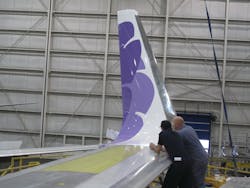Cover Story: MRO Operations: Large Aircraft Modifications
In the October 2010 issue of AMT magazine the subject of performance upgrades to business and corporate use aircraft was discussed with one of the manufacturers of this type of aircraft. The article described some of the reasons why owners upgrade aircraft and their potential impact to future maintenance.
Similar to their smaller siblings, large transport category aircraft operated by airlines often undergo the same types of upgrades and modifications such as interior refurbishment, installation of passenger convenience items, and modifications to gain greater performance.
To talk about modifications and upgrades to large transport category aircraft, AMT visited Aviation Technical Services (ATS), a large MRO provider located at Paine Field in Everett, WA. ATS provides MRO services primarily for Boeing narrow and widebody aircraft. Two very different types of modifications were used as examples to discuss the more important issues of project planning and relationship building between the customer, the suppliers, and the MRO provider.
Winglet installations
You can’t pass by any commercial airport these days without noticing how many aircraft have large wingtip devices on the ends of their wings. Aircraft are delivered from the factory with these efficiency gaining devices while others are retrofit installations. One company that supplies these devices for Boeing aircraft is Aviation Partners Boeing (APB). APB is a joint venture between Aviation Partners Inc. and the Boeing Company.
APB engineered and obtained a supplemental type certificate (STC) for its devices and supplies an STC kit which includes the winglet, hardware and parts, instructions, and the associated workcards. The airline or customer either hires the services of an MRO provider, or if able they accomplish the installation themselves. APB supplies these kits for installation on several of the Boeing 737 family of aircraft, the Boeing 757-200 and -300, and the Boeing 767-300ER. They are also available on installation on new production Boeing 737 aircraft. Many MRO providers and airlines have experience installing the APB Blended Winglets including ATS. ATS accomplished the first Boeing 737 prototype APB Blended Winglet installation.
ATS explains some of the details of the installation on the Hawaiian Airlines Boeing 767-300ER, and the discussion rapidly turned toward the importance of early planning for any new large-scale project. Installation of these devices requires several structural modifications to the outboard section of the wing.
A 14- foot section of the original upper and lower wing-skins is removed to accommodate the addition of new structure. Two new internal stringers are installed on both the upper and lower wing skins the length of the wing requiring full access to the inside of both wings. Several new ribs and other new structures are installed near the outboard section of the wing. Large fixtures and tooling are involved for location and alignment throughout the project. Eventually all wing modifications are accomplished and the winglets are bolted onto the end of the wings.
Sound simple; we know it's not. Mike Beck, director business development, shares, “Our experience with any large scale modification is it takes up to three aircraft to achieve what we call a steady-state. At that point we're down the learning curve, technicians and engineering staff have a routine, working relationships are established, and the project moves efficiently. A lot of work goes into properly planning a project like this.”
David Keimig, director of operations, shares, “As with most large projects, technical deviations sometimes surface for a variety of reasons during the project. With this project they are managed by our engineering group working directly with the airline customer and the APB engineering groups. This is where the early relationship building comes into the project.”
In-flight entertainment systems (IFE)
Travel on most any airliner today and you have right in front of you a monitor for the in-flight entertainment systems (IFE). Lumexis Corporation contracted with ATS to install its first ever Lumexis FTTS system on a customer’s new post-delivery B737-800. Not only was it the first fiber-optic IFE system for aircraft, but being the first Boeing Sky interior delivery it added even more unique challenges. The first project included removal of the existing seats, parts of the interior, installation of the fiber optic cable system, the main control system, and installation of the preassembled seats with monitors installed in them. This particular project includes a total of 44 new aircraft.
Phil Fields, vice president business development, says of the Lumexis project, “ATS was chosen over one year prior to the first aircraft being accomplished. A large effort went into planning this project. All the necessary ATS departments and people were involved in the planning meetings all the way through to the first aircraft.”
Brian Kucherepa, installation manager for Lumexis Corporation, shares what he feels makes a successful project. “Communication and open working relationships between the airline, supplier, and the MRO provider. With such tight schedules if you have any communication breakdowns it could lead to delays from hours to days.” Kucherepa goes on to say, “Without good planning you have less time to recover from unknown issues that may jump up. ATS was very well prepared and was always able to supply manpower and knowledge to every situation that arose during the installation." Kucherepa concludes by saying, “When working with an MRO provider from C-checks to IFE installations it's important to have a solid team involved.”
The dedicated crew concept
Landon Nitschke, vice president of operations, explains what they call the unique aircraft vVisit (UAV) crew concept. Nitschke shares, “Planning and scheduling the technical work force for large modification projects can be a daunting task and can also be disruptive to the routine work being performed in any maintenance organization. We’ve been experimenting with a crew dedicated to all off-schedule projects no matter if they are avionics installations, interiors, structural modifications, or drop-in maintenance.”
With the amount of work ATS has, the dedicated crew concept works well. Nitschke explains the UAV concept has been tried on several different airlines, different aircraft types, and different types of work including damage repair, lightning strike repairs, or the large scale modifications. ATS establishes a crew to produce a certain amount of work each day and factors in about a 10 percent variation to that plan. When questioned on having technicians working avionics projects one day and structural modifications the next, Nitschke says, “We still have to borrow technicians for specialized skills but we try very hard to not disrupt the routine heavy-check crews. We have approximately 75 people that we use for UAV work with a cross-section of skills.”
Keimig says, “At ATS more aircraft are going through drop-in maintenance and modifications than do the routine heavy-check work. There are efficiencies gained by having the same crews working these unique projects nose-to-tail. We feel there are benefits to us and to our customers.”
Shared best practices
Beck stresses the importance of early planning regardless of whether work is routine or a complex modification. Beck shares, “We perform what we call scripting before starting any projects. It’s a dry run consisting of all the people involved and includes all materials, workcards, instructions, inspection requirements, tools, fixtures, software programs; etc. I can’t stress enough the importance of this exercise for any large modification.”
Keimig says, “Sorting through the material kits well in advance of induction of the aircraft is very important, especially with interior-related projects. Unfortunately as good as the suppliers are you are likely to still have missing items or items with incorrect part numbers. The key to success with material kits is to find this out well ahead of time instead of during installation.”
Fields concludes, “This brings us to the point that airline customers should choose their maintenance partner early. The MRO provider will be reluctant to go too far into the planning phase during the early stages of contract negotiations if they don’t receive the work.” Fields calls this the Bid Barrier, referring to a customer requesting bid quotes from numerous MRO providers and working through the selection and approval processes, all the while the clock is ticking and the first aircraft induction date is rapidly approaching. Fields also offers that the airline’s engineering department and the MRO providers engineering department don’t always build a relationship early enough in the program. Field shares, “The down-stream impact to the MRO provider’s efficiency working the program can be huge.”
For more information you can visit www.atsmro.aero, www.aviationpartnersboeing.com, and www.lumexis.com

